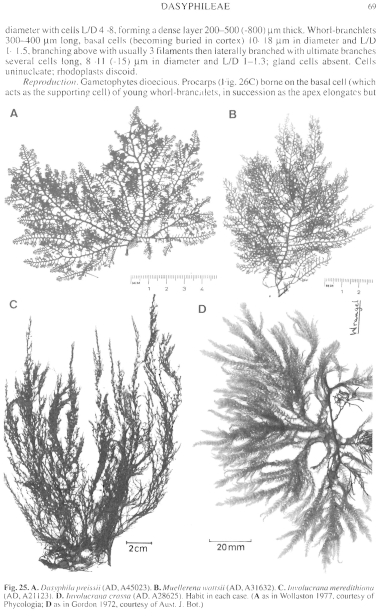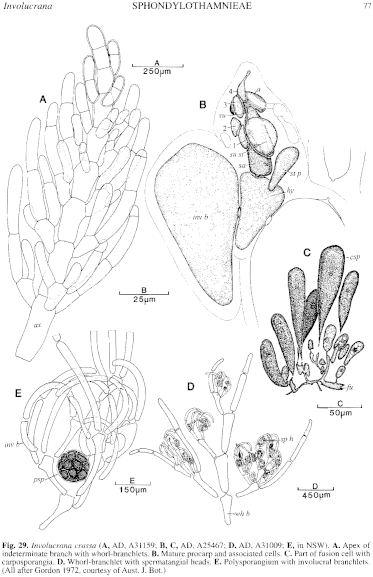|
|
|
|
|
|||||||||||
|
Electronic Flora of South Australia Species Fact Sheet
Phylum Rhodophyta – Order Ceramiales – Family Ceramiaceae – Tribe Sphondylothamnieae
Synonym
Wrangelia crassa Hooker & Harvey 1847: 410. J. Agardh 1852: 706; 1876: 620. De Toni 1897: 131. Guiler 1952: 99. Harvey 1859b: 308; 1863, synop.: xxviii. Kützing 1849: 665. Lucas 1909: 23; 1929a: 16; 1929b: 48. Lucas & Perrin 1947: 138. May 1965: 366. Silva et al. 1996: 415. Sonder 1881: 29. Tisdall 1898: 511. Wilson 1892: 170. Womersley 1950: 181.
Thallus (Fig. 25D) dark red-brown, 5–20 cm high, branched alternately and distichously for 3–4 orders, with some long branches with hamate tips, erect axes arising from prostrate basal branches or from a matted holdfast 2–10 mm across; epiphytic on larger algae or possibly epilithic. Structure. Subapical cells forming opposite, distichous pairs of whorl-branchlets (Fig. 29A), with occasionally a third and rarely a fourth opposite the third, axial cells 600–800 µm in diameter and L/D 2–5 below. Mature whorl-branchlets 2.5–4 mm long, spreading and overlapping, subpolychotomous at their base and subtri- to dichotomous above, ultimate branches of 1–3 cells, ends of terminal cells rounded, median cells 200–300 µm in diameter and L/D 2.5–6; further laterals are produced from basal cells of whorl-branchlets in the lower thallus, obscuring the distichous arrangement of whorl-branchlets. Indeterminate branches arising in the position of whorl-branchlets on axial cells; on some branches the axial cells near apices bear reduced, or no, whorl-branchlets and the end becomes curved. Cortication of lower axes occurs by rhizoids from the lower ends of cells. Cells multinucleate; rhodoplasts discoid to elongate.
Reproduction: Gametophytes dioecious. Female axis (Fig. 29B) of 3 cells, arising distally and adaxially from the subterminal cell of a young whorl-branchlet, the subapical cell bearing two pericentral cells, one (the supporting cell) bearing a terminal sterile cell and a lateral carpogonial branch; fusion cell lobed, with anastomosing processes bearing terminal clavate carposporangia (Fig. 29C) 35–50 µm in diameter; carposporophyte 450–700 µm across; 3 inner involucral branchlets surround the carposporophyte, with an outer involucre from the lower whorl-branchlets. Spermatangial heads (Fig. 29D) ovoid, 80–100 µm in diameter, situated on reduced branch systems borne on lower to upper cells of whorl-branchlets.
Polysporangia with 27–32 spores (Fig. 29E), 100–220 µm in diameter, occur, borne terminally or laterally on lower cells of whorl-branchlets, surrounded by curved involucral filaments arising from the basal cell.
Type from Georgetown, Tas. (Gunn); lectotype in BM.
Selected specimens: Elliston, S. Aust., drift (Womersley, 13.i.1951; AD, A13527) and 10–11 m deep on limestone in bay (Shepherd, 20.x.1969; AD, A35015). West Point, Eyre Pen., S. Aust., 10–12 m deep (Shepherd, 25.x.1969; AD, A34928). Price I., off Point Avoid, S. Aust., 21 m deep (Branden, 6.i.1989; AD, A59970). Daly Head, Yorke Pen., S. Aust., drift (Gordon, 26.iii.1967; AD, A31009). Victor Harbor, S. Aust., drift (Womersley, 17.x.1948; AD, A9213). Cape du Couedic, Kangaroo I., S. Aust., drift (Womersley, 13.i.1947; AD, A4460). Vivonne Bay, Kangaroo I., S. Aust., drift (Womersley, 2.i.1949; AD, A10664). Seal Bay, Kangaroo 1., S. Aust., drift (Gordon, 21.i.1965; AD, A28625). Pennington Bay, Kangaroo I., in low rock pool (Womersley, 17.i.1944; AD, A2617). Robe, S. Aust., drift (Gordon, 26.i.1967; AD, A31 [59). Nora Creina, S. Aust., drift (Womersley, 8.viii.l961; AD, A25467). 1.3 km off Cape Northumberland, S. Aust., 15 m deep (Shepherd, 9.ii.1977; AD, A55200). Lady Julia Percy I., Vic., 20 m deep (Shepherd, 4.i.1968; AD, A32457). Red Rocks, Phillip I., Vic., 4–6 m deep (Riddle, 12.ii.1990; AD, A60162). Gabo I., Vic., 28 m deep (Shepherd, 19.ii.1973; AD, A43536). Middleton, SE Tas. (Perrin, Sept. 1940; AD, A48173).
Distribution: Elliston, S. Aust., to Gabo I., Vic., and N and E Tasmania. Specimens from Fremantle, W. Aust. (Clifton, July 1858) and Kiama, N.S.W., are in BM. Millar & Kraft (1993, p. 41) comment on absence of any other N.S.W. records, and both these records need verification.
Taxonomic notes: Involucrana crassa is a deep water alga, known mainly from drift specimens, on rough-water coasts; rarely it occurs in shallow, shaded, situations.
References:
AGARDH, J.G. (1852). Species Genera et Ordines Algarum. Vol. 2, Part 2, pp. 337–720. (Gleerup: Lund.)
AGARDH, J.G. (1876). Species Genera et Ordines Algarum. Vol. 3, Part 1- Epicrisis systematic Floridearum, pp. i-vii, 1–724. (Weigel: Leipzig.)
DE TONI, G.B. (1897). Sylloge Algarum omnium hucusque Cognitarum. Vol. 4. Florideae. Sect. 1, pp. 1–388. (Padua.)
GORDON, E.M. (1972). Comparative morphology and taxonomy of the Wrangelieae, Sphondylothamnieae and Spermothamnieae (Ceramiaceae, Rhodophyta). Aust. J. Bot. suppl. 4, 1–180.
GUILER, E.R. (1952). The marine algae of Tasmania. Checklist with localities. Pap. Proc. R. Soc. Tasmania 86, 71–106.
HARVEY, W.H. (1859b). Algae. In Hooker, J.D., The Botany of the Antarctic Voyage. III. Flora Tasmaniae. Vol. II, pp. 282–343, Plates 185–196. (Reeve: London.)
HARVEY, W.H. (1863). Phycologia Australica. Vol. 5, Plates 241–300, synop., pp. i-lxxiii. (Reeve: London.)
HOOKER, J.D. & HARVEY, W.H. (1847). Algae Tasmanicae. Lond. J. Bot. 6, 397–417.
KÜTZING, F.T. (1849). Species Algarum. (Leipzig.)
LUCAS, A.H.S. & PERRIN, F. (1947). The Seaweeds of South Australia. Part 2. The Red Seaweeds. (Govt Printer: Adelaide.)
LUCAS, A.H.S. (1909). Revised list of the Fucoideae and Florideae of Australia. Proc. Linn. Soc. N.S.W. 34, 9–60.
LUCAS, A.H.S. (1929a). The marine algae of Tasmania. Pap. Proc. R. Soc. Tasm. 1928, 6–27.
LUCAS, A.H.S. (1929b). A census of the marine algae of South Australia. Trans. R. Soc. S. Aust. 53, 45–53.
MAY, V. (1965). A census and key to the species of Rhodophyceae (red algae) recorded from Australia. Contr. N.S.W. natn. Herb. 3, 349–429.
MILLAR, A.J.K. & KRAFT, G.T. (1993). Catalogue of marine and freshwater Red Algae (Rhodophyta) of New South Wales, including Lord Howe Island, South-western Pacific. Aust. Syst. Bot. 6, 1–90.
SILVA, P.C., BASSON, P.W. & MOE, R.L. (1996). Catalogue of the Benthic Marine Algae of the Indian Ocean. (University of California Press: Berkeley, Los Angeles & London.)
SONDER, O.W. (1881). In Mueller, F., Fragmenta Phytographiae Australiae. Supplementum ad volumen undecinum: Algae Australianae hactenus cognitae, pp. 1–42, 105–107. (Melbourne.)
TISDALL, H.T. (1898). The algae of Victoria. Rep. 7th Meet. Aust. Ass. Adv. Sci., Sydney, 1898, pp. 493–516.
WILSON, J.B. (1892). Catalogue of algae collected at or near Port Phillip Heads and Western Port. Proc. R. Soc. Vict. 4, 157–190.
WOMERSLEY, H.B.S. (1950). The marine algae of Kangaroo Island. III. List of Species 1. Trans. R. Soc. S. Aust. 73, 137–197.
The Marine Benthic Flora of Southern Australia Part IIIC complete list of references.
Publication:
Womersley, H.B.S. (24 December, 1998)
The Marine Benthic Flora of Southern Australia
Rhodophyta. Part IIIC. Ceramiales – Ceramiaceae, Dasyaceae
©State Herbarium of South Australia, Government of South Australia
Illustrations in Womersley Part IIIA, 1998: FIGS 25D, 29.

Figure 25 enlarge
Fig. 25. A. Dasyphila preissii (AD, A45023). B. Muellerena wattsii (AD, A31632). C. Involucrana meredithiana (AD, A21123). D. Involucrana crassa (AD, A28625). Habit in each case. (A as in Wollaston 1977, courtesy of Phycologia; D as in Gordon 1972, courtesy of Aust. J. Bot.)

Figure 29 enlarge
Fig. 29. Involucrana crassa (A, AD, A31159; B, C, AD, A25467; D, AD, A31009; E, in NSW). A. Apex of indeterminate branch with whorl-branchlets. B. Mature procarp and associated cells. C. Part of fusion cell with carposporangia. D. Whorl-branchlet with spermatangial heads. E. Polysporangium with involucral branchlets. (All after Gordon 1972, courtesy of Aust. J. Bot.)

|
Email Contact: State Herbarium of South Australia |

|